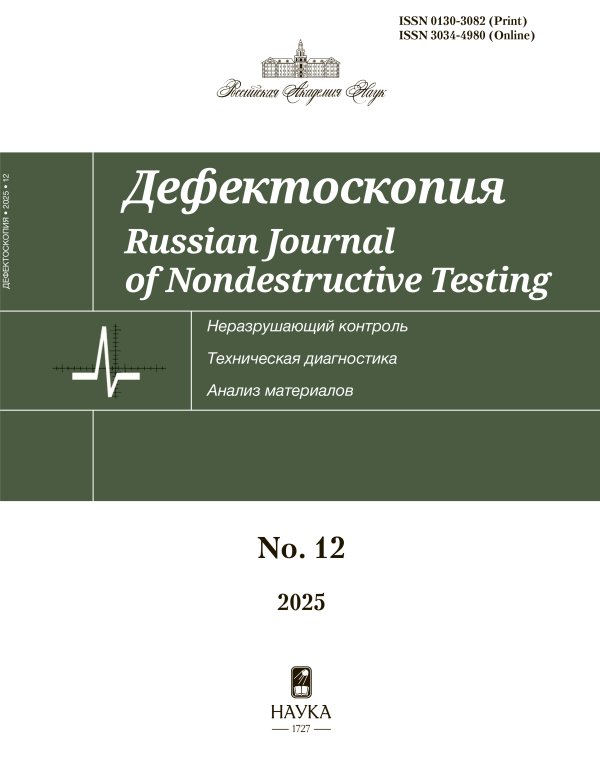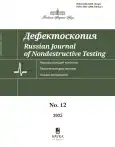Russian Journal of Nondestructive Testing
Current Issue
No 12 (2025)
Acoustic methods
ULTRASONIC IMAGING VIA DIGITAL ANTENNA FOCUSING TECHNIQUE USING HIGH-FREQUENCY LAMB WAVES
Abstract
Ultrasonic testing using guided waves, particularly Lamb waves, is a powerful tool for inspecting thin objects. This paper considers the implementation of ultrasonic testing with Lamb waves using digital antenna focusing technique (DFA). By using high-frequency Lamb waves generated through the use of wedges, it is possible to perform ultrasonic testing using conventional ultrasound equipment. To enhance the quality of the image restoration, a post-processing approach has been proposed, which combines the application of conventional algorithm within DFA and Phase Coherent Imaging (PCI). Experimental results demonstrate that this combined approach effectively restores images of flaws located at various depths with high signal-to-noise ratios, demonstrating the promising potential for this technique in pulse-echo ultrasonic inspection. These findings expand the range of applications for phased-array ultrasonic systems
 3-12
3-12


Electromagnetic methods
DIRECT PROBLEM OF MAGNETOSTATICS FOR A UNIFORMLY MAGNETIZED CYLINDER
Abstract
Formulas for calculating the strength of the reaction field inside and outside a uniformly magnetized magnet in the form of a cylinder of finite dimensions are obtained. A Fortran program has been written that implements the methodology proposed on the basis of these formulas. The possibilities of applying this method to solve the geometric inverse problem of magnetostatics for magnetics or for through and internal cavities of the corresponding shape were discussed. The obtained formulas were tested for their compliance with physical laws, as well as with known formulas for both specific cases of the considered configuration and the limiting cases of the studied geometric shape of the magnet
 13-24
13-24


MAGNETIC PROPERTIES OF LOW-CARBON STEEL PLATE UNDER ELASTIC BENDING
Abstract
Experimental field dependences of the measuring coil signal, proportional to the reversible magnetic permeability, were obtained on an elastically deformed (by bending) plate made of low-carbon steel 20 during its remagnetization along the major hysteresis loop by a U-shaped attached electromagnet (AEM). Additionally, during magnetization, a local area of the plate was subjected to a variable magnetic field using a flat coil placed between the poles of the AEM. The measuring coil, located on the same frame as the bias coil, was in contact with the plate surface. Magnetic property measurements were taken from both sides of the plate in its central part. It was established that the curves measured with the AEM installed on the top and bottom of the deformed plate differ significantly. On the curves measured from the top side of the plate, where the surface experiences maximum compressive stresses, one central peak in the region of the coercive force and two additional inflections (peaks) on both sides of it are observed. On the curves measured from the tension side of the plate, additional inflections were observed only at low frequencies of the bias field, when the signal from the measuring coil also contained information about the compressed layers of the plate. The fields at which the inflections occur depend both on the applied load (magnitude of stresses) and on the frequency of the bias field generated by the primary transducer coil. The dependence of the average field of the peaks on the load applied to the plate is close to linear
 25-34
25-34


APPLICABILITY OF MAGNETIC MEASUREMENTS TO THE DETECTION OF FRACTURE NUCLEATION IN 09G2S STEEL
Abstract
The paper presents results of local magnetic measurements at various regions of two 09G2S steel specimens plastically deformed by uniaxial tension. The first specimen was deformed to crack formation, while the second was deformed to the initiation of necking (before the initiation of strain localization). Magnetic characteristics were determined in both the major magnetization reversal cycle and the minor magnetization reversal cycles in medium and weak fields. The fundamental possibility of applicability of locally measured magnetic properties of plastically deformed steel products in the minor magnetization reversal cycles in medium and weak fields to the detection of potential nuclei is experimentally demonstrated. It is shown that the presence of peaks, their magnitudes, and the magnetic field strengths at which they form on the field dependence of differential magnetic permeability can be used to obtain information about the strain corresponding to the test object region
 35-47
35-47


Optical methods
SPECKLE INTERFEROMETRY FOR RECORDING MICRO-DISPLACEMENTS AND DEFORMATIONS: OVERVIEW OF METHODS
Abstract
This article examines a class of speckle interferometry methods suitable for measuring mechanical and thermal deformations, flaw detection, structural damage monitoring, and vibration testing of large objects. It describes the historical development of speckle interferometry, from manual image processing to the most advanced methods capable of simultaneously determining all three directions of deformation. Several classification schemes for speckle interferometry have been proposed. Applications of the method in various industrial fields are analyzed. Various objects are considered, including industrial metal products, organic materials, composite materials, and others. Industrial solutions based on electronic speckle pattern interferometry are presented
 48-63
48-63


Radiation methods
DETECTION OF WELD DEFECT IMAGES IN RADIOGRAPHS UNDER CONDITIONS OF LIMITED INFORMATION ON CONTROL SENSITIVITY
Abstract
This article is devoted to improving the efficiency of segmentation of radiographic images of welded joints. The article presents an algorithm for defect image segmentation, which is performed in two stages: determination of an array of thresholds for detecting defect image pixels (various detection thresholds for defect image pixels located in areas of digital radiographic images of welded joints with characteristic brightness distribution and background brightness estimation errors) on the background sample based on the criterion of avoiding the detection of “false” defect images; and the actual search for defect images. The experimental results confirm the applicability of the developed algorithm for effective detection of defect images in radiographic images of welded joints without the use of reference sensitivity standards
 64-75
64-75












